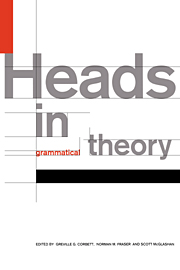Book contents
- Frontmatter
- Contents
- List of contributors
- 1 Introduction
- 2 The head of Russian numeral expressions
- 3 The phonology of heads in Haruai
- 4 Patterns of headedness
- 5 Head-hunting: on the trail of the nominal Janus
- 6 The headedness of noun phrases: slaying the nominal hydra
- 7 Head- versus dependent-marking: the case of the clause
- 8 Heads in discourse: structural versus functional centricity
- 9 Heads in Head-driven Phrase Structure Grammar
- 10 Heads and lexical semantics
- 11 Heads, parsing and word-order universals
- 12 Do we have heads in our minds?
- 13 Heads, bases and functors
- References
- Index
12 - Do we have heads in our minds?
Published online by Cambridge University Press: 23 February 2010
- Frontmatter
- Contents
- List of contributors
- 1 Introduction
- 2 The head of Russian numeral expressions
- 3 The phonology of heads in Haruai
- 4 Patterns of headedness
- 5 Head-hunting: on the trail of the nominal Janus
- 6 The headedness of noun phrases: slaying the nominal hydra
- 7 Head- versus dependent-marking: the case of the clause
- 8 Heads in discourse: structural versus functional centricity
- 9 Heads in Head-driven Phrase Structure Grammar
- 10 Heads and lexical semantics
- 11 Heads, parsing and word-order universals
- 12 Do we have heads in our minds?
- 13 Heads, bases and functors
- References
- Index
Summary
Heads without mentalism
The main point of this chapter is that heads must be among the categories used in the mental representations that ordinary people construct when they hear and utter sentences. In other words, the category ‘head’ and the associated concept ‘dependent’ are psychologically real; and they are real not only in grammars but also in sentence structure. However, we start with some non-psychological considerations about heads.
Heads in grammars and in sentence structure: a survey of theories
The distinction between grammars and sentence structure is an important one, because it is possible to accept the need for heads in the grammar without recognizing them in sentence structure. As Arnold Zwicky pointed out (1988), this possibility is exploited in Generalized Phrase Structure Grammar (GPSG), where the head daughter is represented in the relevant phrase-structure rule as simply ‘H’ (Gazdar et al., 1985: 51), but this is just a conventional abbreviation which is replaced, in the corresponding phrase marker, by all the ‘head features’ of the mother node. But these ‘head features’ are just ordinary features which do not in themselves show explicitly that the head is the head; the head is different from the other daughters only in that its features are the same as those of the mother.
- Type
- Chapter
- Information
- Heads in Grammatical Theory , pp. 266 - 291Publisher: Cambridge University PressPrint publication year: 1993
- 3
- Cited by



